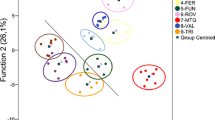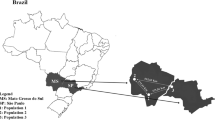Abstract
Cuticular hydrocarbons are among the prime candidates for nestmate recognition in social insects. We analyzed the variation of cuticular hydrocarbons in the termite species M. subhyalinus in West Africa (Comoë National Park) on a small spatial scale (<1 km). We found considerable variation in the composition of cuticular hydrocarbons among colonies, with four distinct chemical phenotypes. Different phenotypes occurred within each of the four habitats. The difference between these phenotypes is primarily due to unsaturated compounds. A clear correlation between the difference of the hydrocarbon composition and the aggression between colonies was found. This correlation also holds in a multivariate analysis of genetic similarity (measured by AFLPs), morphometric distances (measured by Mahalanobis-distances), as well as geographic distances between colonies. In a more detailed analysis of the correlation between the composition of cuticular hydrocarbons and aggression, we found that no single compound is sufficient to explain variation in aggression between pairings of colonies. Thus, termites seem to use a bouquet of compounds. Multiple regression analysis suggested that many of these compounds are unsaturated hydrocarbons and, thus, may play a key role in colony recognition.
Similar content being viewed by others
REFERENCES
Adams, E. S. 1991. Nest-mate recognition based on heritable odors in the termite Microcerotermes arboreus. Proc. Natl. Acad. Sci. USA 88:2031–2034.
Bagine, R. K. N., Brandl, R., and Kaib, M. 1994. Species delimitation in Macrotermes (Isoptera: Macrotermitidae): Evidence from epicuticular hydrocarbons, morphology, and ecology. Ann. Entomol. Soc. Amer. 87:498–506.
Bagnères, A. G., Killian, A., Clément, J. L., and Lange, C. 1991. Interspecific recognition among termites of the genus Reticulitermes: Evidence for a role for the cuticular hydrocarbons. J. Chem. Ecol. 17:2397–2420.
Beye, M., Neumann, P., and Moritz, R. F. A. 1997. Nestmate recognition and the genetic gestalt in the mound-building ant Formica polyctena. Insectes Soc. 44:49–58.
Blomquist, G. J., Nelson, D. R., and De Renobales, M. 1987. Chemistry, biochemistry, and physiology of insect cuticular waxes. Arch. Insect Biochem. Physiol. 6:227–265.
Blomquist, G. J., Tillman, J. A., Mpuru, S., and Seybold, S. J. 1998. The cuticle and cuticular hydrocarbons of insects: Structure, function, and biochemistry, pp. 34–54, in R. K. Vander Meer, M. D. Breed, K. E. Espelie, and M. L. Winston (eds.). Pheromone Communication in Social Insects. Westview Press, Boulder, CD.
Bonavita-Cougourdan, A., Clément, J. L., and Lange, C. 1987. Nestmate recognition: The role of cuticular hydrocarbons in the ant Camponotus vagus Scop. J. Entomol. Sci. 22:1–10.
Breed, M. D. 1998. Chemical cues in kin recognition: Criteria for identification, experimental approaches, and the honey bee as an example, pp. 57–78, in R. K. Vander Meer, M. D. Breed, K. E. Espelie, and M. L. Winston (eds.). Pheromone Communication in Social Insects. Westview Press, Boulder, CD.
Breed, M. D. and Bennett, B. 1987. Kin recognition in highly eusocial insects, pp. 243–285, in D. J. C. Fletcher and C. D. Michener, (eds.). Kin Recognition in Animals. Wiley, Chichester, UK.
Breed, M. D., Leger, E. A., Pearce, A. N., and Wang, Y. J. 1998. Comb wax effects on the ontogeny of honey bee nestmate recognition. Anim. Behav. 55:13–20.
Brown, W. V., Watson, J. A. L., Lacey, M. J., Morton, R., and Miller, L. R. 1996. Composition of cuticular hydrocarbons in the Australian harvester termite repanotermes perniger (Isoptera: Termitidae): Variation among individuals, castes, colonies, and locations. Sociobiol. 27:181–197.
Buckle, G. R. and Greenberg, L. 1981. Nestmate recognition in sweat bees (Lasioglossum zephyrum): Does an individual recognize its own odour or only odours of its nestmates? Anim. Behav. 29:802–809.
Carlin, N. F. and HÖlldobler, B. 1986. The kin recognition system of carpenter ants (Camponotus spp.) I. Hierarchical cues in small colonies. Behav. Ecol. Sociobiol. 19:123–134.
Chevan, A. and Sutherland, M. 1991. Hierarchical partitioning. Amer. Statist. 45:90–96.
Clément, J.-L. and Bagnères, A.-G. 1998. Nestmate recognition in termites, pp. 126–155, in R. K. Vander Meer, M. D. Breed, K. E. Espelie, and M. L. Winston (eds.). Pheromone Communication in Social Insects. Westview Press, Boulder, CD.
Dani, R. F., Fratini, S., and Turrilazzi, S. 1996. Behavioural evidence for the involvement of Dufour's gland secretion in nestmate recognition in the social wasp Polistes dominulus (Hymenoptera: Vespidae). Behav. Ecol. Sociobiol. 38:311–319.
Gamboa, G. J., Grudzien, T. A., Espelie, K. E., and Bura, E. A. 1996. Kin recognition pheromones in social wasps: Combining chemical and behavioral evidence. Anim. Behav. 51:625–629.
Gamboa, G. J., Reeve, H. K., and Holmes, W. G. 1991. Conceptual issues and methodology in kin-recognition research: A critical discussion. Ethology 88:109–127.
Gamboa, G. J., Reeve, H. K., Ferguson, I. D., and Wacker, T. L. 1986. Nestmate recognition in social wasps: The origin and acquisition of recognition odours. Anim. Behav. 34:685–695.
Greenberg, L., 1979. Genetic component of bee odor in kin recognition. Science 206:1095–1097.
Haverty, M. I. and Nelson, L. J. 1997. Cuticular hydrocarbons of Reticulitermes (Isoptera: Rhinotermitidae) from northern California indicate undescribed species. Comp. Biochem. Physiol. B118:868–880.
Haverty, M. I. and Thorne, B. L. 1989. Agonistic behavior correlated with hydrocarbon phenotypes in dampwood termites, Zootermopsis (Isoptera: Termopsidae). J. Insect Behav. 2:523–543.
Haverty, M. I., Nelson, L. J., and Forschler, B. T. 1999. New cuticular hydrocarbon phenotypes of Reticulitermes (Isoptera: Rhinotermitidae) from the United States. Sociobiology 34:1–21.
Haverty, M. I., Forschler, B. T., and Nelson, L. J. 1996a. An assessment of the taxonomy of Reticulitermes (Isoptera: Rhinotermitidae) from the southeastern United States based on cuticular hydrocarbons. Sociobiol. 28:287–318.
Haverty, M. I., Grace, J. K., Nelson, L. J., and Yamamoto, R. T. 1996b. Intercaste, intercolony, and temporal variation in cuticular hydrocarbons of Coptotermes formosanus Shiraki (Isoptera:Rhinotermitidae). J. Chem. Ecol. 22:1813–1834.
Haverty, M. I., Page, M., Nelson, L. J., and Blomquist, G. J. 1988. Cuticular hydrocarbons of dampwood termites, Zootermopsis: Intra-and intercolony variation and potential as taxonomic characters. J. Chem. Ecol. 14:1035–1058.
Haverty, M. I., Thorne, B. L., and Nelson, L. J. 1996c. Hydrocarbons of Nasutitermes acajutlae and comparison of methodologies for sampling cuticular hydrocarbons of Caribbean termites for taxonomic and ecological studies. J. Chem. Ecol. 22:2081–2109.
Heinze, J., Foitzik, S., Hippert, A., and HÖlldobler, B. 1996. Apparent dear-enemy phenomenon and environment-based recognition cues in the ant Leptothorax nylanderi. Ethology 102:510–522.
Henderson, G., Andersen, J. F., Phillips, J. K., and Jeanne, R. L. 1990. Internest aggression and identification of possible nest mate discrimination pheromones in polygynous ant Formica montana. J. Chem. Ecol. 16:2217–2228.
HÖlldobler, B. and Michener, C. D. 1980. Mechanisms of identification and discrimination in social Hymenoptera, pp. 35–58 in H. Markl, (ed.). Evolution of Social Behavior: Hypotheses and Empirical Tests, Verlag Chemie, Weinheim, Germany.
HÖlldobler, B. and Wilson, E. O. 1990. The Ants. The Belknap Press of Harvard University Press, Cambridge, MA.
Howard, R. W., McDaniel, C. A., Nelson, D. R., Blomquist, G. J., Gelbaum, L. T., and Zalkow, L. H. 1982. Cuticular hydrocarbons of Reticulitermes virginicus (Banks) and their role as potential species-and caste-recognition cues. J. Chem. Ecol. 8:1227–1239.
Husseneder, C., Brandl, R., Epplen, C., Epplen, J. T., and Kaib, M. 1998. Variation between and within colonies in a termite: Morphology, genomic DNA, and behaviour. Mol. Ecol. 7:983–990.
Husseneder, C., Kaib, M., Epplen, C., Epplen, J. T., and Brandl, R. 1997. Small scale population structure of the termite Schedorhinotermes lamanianus: Aggression modulated by genetic and environmental factors. Mitt. dtsch. Gesell. allg. angew. Ent. 11:183–187.
Jmhasly, P. and Leuthold, R. H. 1999. Intraspecific colony recognition in the termites Macrotermes subhyalinus and Macrotermes bellicosus (Isoptera: Termitidae). Insectes Soc. 46:164–170.
Kaib, M., Franke, S., Francke, W., and Brandl, R. 2002. Cuticular hydrocarbons in a termite: Phenotypes and a neighbour-stranger effect. Physiol. Entomol. 27:189–198.
Kaib, M., Brandl, R., and Bagine, R. K. 1991. Cuticular hydrocarbon profiles: A valuable tool in termite taxonomy. Naturwissenschaften 78:176–179.
Kaib, M., Eisermann, B., Schoeters, E., Billen, J., Franke, S., and Francke, W. 2000. Task related variation of postpharyngeal and cuticular hydrocarbon compositions in the ant Myrmicaria eumenoides. J. Comp. Physiol. A 186:939–948.
Kaib, M., Heinze, J., and Ortius, D. 1993. Cuticular hydrocarbon profiles in the slave-making ant Harpagoxenus sublaevis and its hosts. Naturwissenschaften 80:281–285.
Korb, J. 1997. Lokale und regionale Verbreitung von Macrotermes bellicosus (Isoptera; Macrotermitinae): Stochastik oder Deterministik? Wissenschaft und Technik Verlag, Berlin.
MacNally, R. 2000. Regression and model-building in conservation biology, biogeography and ecology: The distinction between—and reconciliation of—“predictive” and “explanatory” models. Biodiv. Conserv. 9:655–671.
Manly, B. F. J. 1997. Randomization, Bootstrap and Monte Carlo Methods in Biology, 2nd edn. Chapman and Hall, London.
Mintzer, A. and Vinson, S. B. 1985. Kinship incompatibility between colonies of the acacia ant Pseudomyrmex ferruginea. Behav. Ecol. Sociobiol. 17:75–78.
Nelson, D. R., Fatland, C. L., Howard, R. W., McDaniel, C. A., and Blomquist, G. J. 1980. Re-analysis of the cuticular methylalkanes of Solenopsis invicta and S. richteri. Insect Biochem. 10:409–418.
Nowbahari, E., Lenoir, A., Clément, J. L., Lange, C., Bagnères, A. G., and Joulie, C. 1990. Individual, geographical and experimental variation of cuticular hydrocarbons of the ant Cataglyphis cursor (Hymenoptera: Formicidae): Their use in nest and subspecies recognition. Biochem. System. Ecol. 18:63–73.
Obin, M. S. 1986. Nestmate recognition cues in laboratory and field colonies of Solenopsis invicta Buren (Hymenoptera: Formicidae). Effect of environment and role of cuticular hydrocarbons. J. Chem. Ecol. 12:1965–1975.
Page, M., Nelson, L. J., Haverty, M. I., and Blomquist, G. J. 1990a. Cuticular hydrocarbons as chemotaxonomic characters for bark beetles: Dendroctonus ponderosae, D. jeffreyi, D. brevicomis, and D. frontalis (Coleoptera: Scolytidae). Ann. Entomol. Soc. Am. 83:892–901.
Page, M., Nelson, L. J., Forschler, B. T., and Haverty, M. I. 2002. Cuticular hydrocarbons suggest three lineages in Reticulitermes (Isoptera: Rhinotermitidae) from North America. Comp. Biochem. Physiol. B131:305–324.
Page, M., Nelson, L. J., Haverty, M. I., and Blomquist, G. J. 1990b. Cuticular hydrocarbons of eight species of North American cone beetles Conophthorus Hopkins. J. Chem. Ecol. 16:1173–1198.
Rohlf, F. J. 1990. NTSYS-pc, Numerical Taxonomy and Multivariate Analysis System. Exeter Software, New York.
Ruelle, J. E. 1970. The revision of the termites of the genus Macrotermes from the Ethiopian region (Isoptera: Termitidae). Bull. Brit. Mus. Nat. Hist. Entomol. 24:365–444.
Shelton, T. G. and Grace, J. K. 1996. Review of agonistic behaviors in the Isoptera. Sociobiology 28:155–176.
Smith, B. H. and Breed, M. D. 1995. The chemical basis for nestmate recognition and mate discrimination in social insects, pp. 287–317 in R. T. Cardé and W. J. Bell (eds.). Chemical Ecology of Insects 2, Chapman and Hall, New York.
Soroker, V., Vienne, C., Hefetz, A., and Nowbahari, E. 1994. The postpharyngeal gland as a “Gestalt” organ for nestmate recognition in the ant Cataglyphis niger. Naturwissenschaften 81:510–513.
Su, N. Y. and Haverty, M. I. 1991. Agonistic behavior among colonies of the Formosan subterranean Termite, Coptotermes formosanus Shiraki (Isoptera: Rhinotermitidae), from Florida and Hawaii: Lack of correlation with cuticular hydrocarbon composition. J. Insect Behav. 4:115–128.
Takahashi, S. and Gassa, A. 1995. Roles of cuticular hydrocarbons in intra-and interspecific recognition behavior of two Rhinotermitidae species. J. Chem. Ecol. 21:1837–1845.
Thorne, B. L. and Haverty, M. I. 1991. A review of intracolony, intraspecific, and interspecific agonism in termites. Sociobiology 19:115–145.
Vos, P., Hogers, R., Bleeker, M., Reijans, M., Van De Lee, T., Hornes, M., Frijters, A., Pot, J., Peleman, J., Kuiper, M., and Zabeau, M. 1995. AFLP: A new technique for DNA fingerprinting. Nucleic Acid Res. 23:4407–4414.
Watson, J. A. L., Brown, W. V., Miller, L. R., Carter, F. L., and Lacy, M. J. 1989. Taxonomy of (Heterotermes) (Isoptera: Rhinotermitidae) in southeastern Australia: Cuticular hydrocarbons of workers, and soldier and alate morphology. Syst. Entomol. 14:299–325.
Author information
Authors and Affiliations
Corresponding author
Rights and permissions
About this article
Cite this article
Kaib, M., Jmhasly, P., Wilfert, L. et al. Cuticular Hydrocarbons and Aggression in the Termite Macrotermes Subhyalinus . J Chem Ecol 30, 365–385 (2004). https://doi.org/10.1023/B:JOEC.0000017983.89279.c5
Issue Date:
DOI: https://doi.org/10.1023/B:JOEC.0000017983.89279.c5




